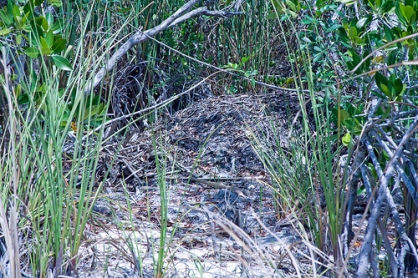City Hall Revealed
May 3, 2009

The Nest
The City Hall subway station was officially closed and abandoned on December 31, 1945. Tours were still offered until quite recently, and now the station has fallen into complete disrepair. Still, the occasional MTA Inspection worker is sent to investigate its conditions. Such is the character of my next interview and thus my next descent into the underground.
City Hall is close to the Canal Street/Chinatown area, and so it seemed a logical location for my next investigation. The street entrances to the station are now sealed, so we entered through a sewer shaft that actually led us to the station. As with the previous descent, I brought two crewmembers with me and left the rest inside the station, and above ground, to monitor our progress and standing.
Diving gear was unnecessary for this attempt because we were going to walk through the abandoned subway line. We did, however, wear long rubber suits, helmets, and the same monitoring and recording devices as before.
This line was not as warm as the sewers had been, but the air was still stagnant and smelled of the refuse floating immediately below and beside the old tracks. We trudged along in the dim light until we saw a large crack in the wall, from which rats were openly and unabashedly scurrying. We decided to go in.Clutching to the wall for guidance, we eventually were led into a larger corridor that seemed to be an abandoned construction site. Water was everywhere, and it floated above our ankles. I later found out that this was an integral portion of the station’s history:
“City Hall Station opened along with the rest of the Interborough’s first subway line on October 27, 1904. It was immediately clear that expansion of the subway system would be necessary and additional lines were built. But ever-increasing ridership eventually required the Interborough’s five-car local stations to be lengthened to accommodate longer trains, and so the IRT underwent an extensive program of station lengthening in the 1940s and early 1950s.
City Hall, due to its architecture and its being situated on a tight curve, was deemed impractical for lengthening. The new longer trains had center doors on each car, and at City Hall’s tight curve, it was dangerous to open them. It was decided to abandon the station in favor of the nearby Brooklyn Bridge station…” (http://www.nycsubway.org/perl/stations?5:979)
Clearly an attempt had been made to expand the station into the surrounding strata. After this had been deemed impossible the site was abandoned altogether, and is now almost completely forgotten by its human progenitors. Because there are only small cracks for air to flow, this site was quite warmer and gave me a distinct feeling of suffocation. Despite this, the plants and animals had not forgotten, nor had they hesitated to take advantage of such a fortuitous situation. They had formed their homes in the rubble, and had appreciated its protected nature. They flourished in this environment. If we were to find an alligator nest or even an alligator themselves, this would have been an ideal location.
And so we did. Tucked in a small corner of the rock lay an alligator’s nest devoid of eggs. Had this been the former home of the egg we found in the sewer? We took some samples and, after searching for a bit more and finding nothing, ascended back to the surface.
I was becoming restless. How could these alligators evade detection so well? Obviously, there were alligators living below the streets of New York. I had only found bare traces of this, though, and was eager to find the alligators themselves. Perhaps the means to avoid detection had been one of their urban adaptations?